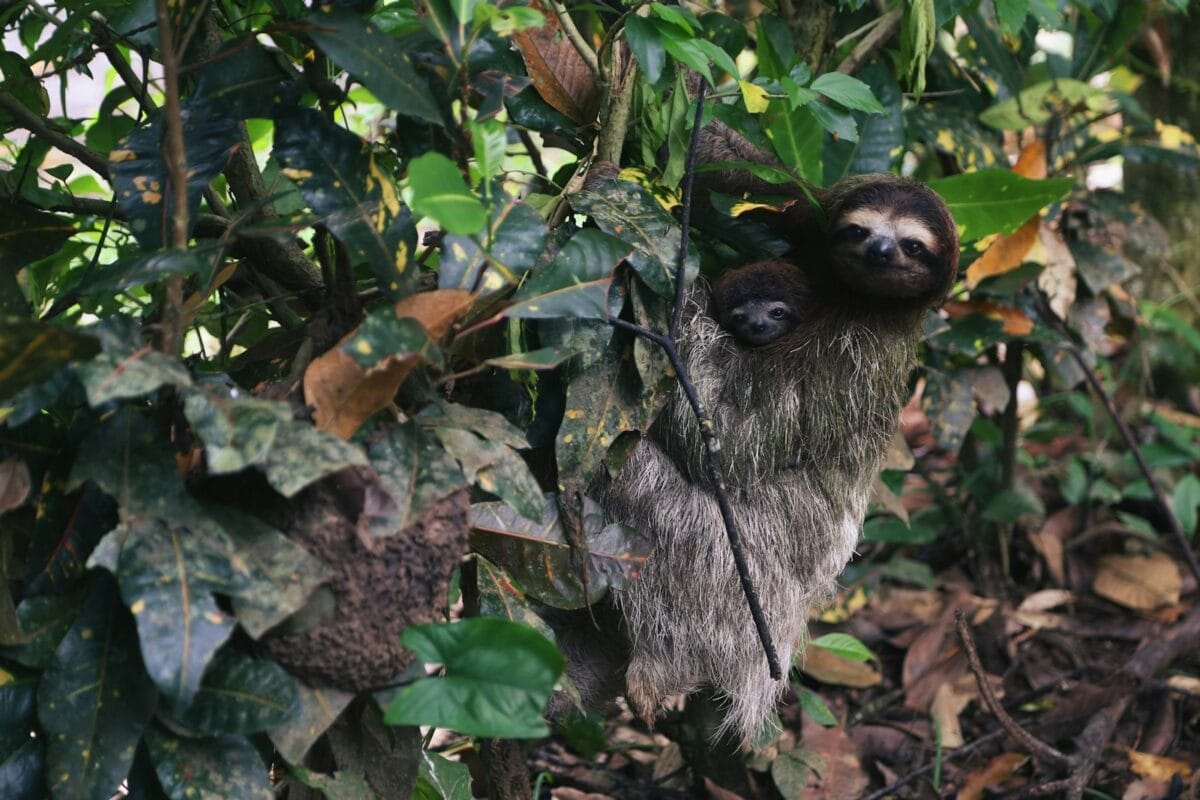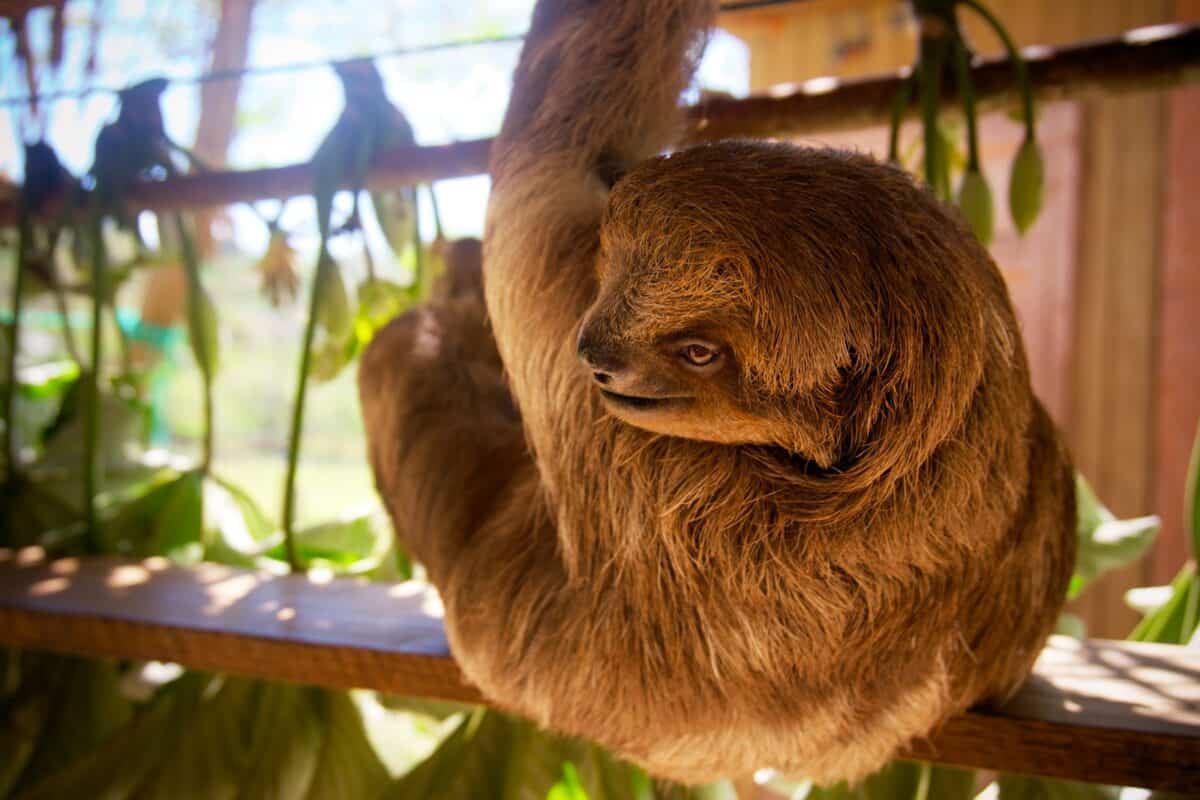Deep in the rainforests of Central and South America, one of nature’s most peculiar digestive systems is silently at work. Sloths, those famously slow-moving arboreal mammals, possess a digestive process so unusual that it defies conventional understanding of mammalian metabolism. Their methodical consumption and processing of food isn’t merely a reflection of their unhurried lifestyle—it’s an extraordinary evolutionary adaptation that has helped these creatures survive for over 60 million years. From multi-chambered stomachs to month-long digestion periods, sloths have developed one of the most energy-efficient digestive systems in the animal kingdom. Let’s explore the fascinating and bizarre world of sloth digestion, where patience isn’t just a virtue—it’s a biological necessity.
The World’s Slowest Metabolism

Sloths possess the slowest digestive system of any mammal on Earth. While humans process food in about 24-72 hours, sloths take an astonishing 30 days or more to completely digest a single meal. This extraordinarily slow metabolism isn’t a defect but a brilliant adaptation that allows these creatures to survive on minimal energy intake. Their metabolic rate is approximately 40-45% lower than would be expected for a mammal of their size. This sluggish processing is perfectly aligned with their energy conservation strategy, enabling them to subsist on a low-calorie diet of leaves that would be insufficient for most mammals of comparable size. Their entire physiology is built around this slow-burning energy system, with even their body temperature fluctuating between 74-92°F (24-33°C), much lower and more variable than most mammals.
A Multi-Chambered Digestive Marvel

At the heart of the sloth’s remarkable digestive system is a complex, multi-chambered stomach that bears more resemblance to that of cows and other ruminants than to most other mammals. Three-toed sloths possess a stomach divided into four chambers, while two-toed sloths have a slightly less complex three-chambered arrangement. These compartments act as fermentation vats where tough plant material sits and slowly breaks down. Unlike true ruminants, sloths don’t regurgitate and rechew their food, but the compartmentalization serves a similar purpose: maximizing nutrient extraction from difficult-to-digest plant matter. The first chamber acts as the primary fermentation site, while subsequent chambers further process the partially digested material, extracting every possible nutrient from their meager diet.
A Microbiome Like No Other

The sloth’s digestive success depends on a remarkably specialized gut microbiome. Their stomachs host a diverse community of bacteria, fungi, and protozoa that break down the cellulose in leaves—a task the sloth’s own digestive enzymes cannot accomplish. Research has revealed that sloth digestive tracts contain novel microorganisms not found in other mammals, with some studies identifying over 120 distinct species of bacteria in their gut flora. This microbial ecosystem has co-evolved with sloths over millions of years, becoming highly specialized for their specific dietary needs. The relationship is so symbiotic that baby sloths will actually consume their mother’s feces to acquire these essential microbes, ensuring they develop the precise gut flora needed for their leaf-based diet.
The Leafy Diet Challenge

Sloths primarily consume leaves, which present a significant nutritional challenge. Leaves are not only low in calories and nutrients but also high in cellulose and often contain toxic compounds that plants produce as defence mechanisms. Three-toed sloths are almost exclusively folivorous (leaf-eaters), with some species specialising in a single tree species for up to 94% of their diet. Two-toed sloths have a slightly more varied diet that may include fruits, flowers, and occasional insects. This nutritional challenge is compounded by the fact that many of their preferred leaves contain toxic alkaloids and phenolic compounds. The sloth’s specialised digestive system detoxifies these compounds through prolonged exposure to gut bacteria, transforming potential poisons into harmless or even beneficial substances.
The Energy Conservation Strategy

The sloth’s bizarre digestive process is part of a comprehensive energy conservation strategy. By digesting food extremely slowly, sloths minimise their energy expenditure. This strategy is reinforced by their inactive lifestyle—sleeping 15-20 hours per day and moving at speeds rarely exceeding 0.15 miles per hour. Even their muscle composition reflects this energy-saving approach, with a higher proportion of slow-twitch muscle fibres that require less energy to maintain. This entire system works in concert with their diet; the slow digestion of leaves provides a steady, albeit minimal, release of energy rather than the peaks and valleys experienced by animals with faster metabolisms. Scientists estimate that a sloth uses only about 110 kilocalories per day—less than 10% of what a human of similar weight requires.
The Weekly Bathroom Break Ritual

Perhaps the most bizarre aspect of sloth digestion is their bathroom routine. Despite their continuous eating, sloths typically defecate only once a week, and this rare event involves a perilous journey to the forest floor. Descending from their arboreal sanctuaries—where they spend 90% of their lives—sloths dig a small hole, empty their bowels, and cover their waste before climbing back up. This weekly excursion accounts for about 30% of a sloth’s total energy budget and exposes them to predation, raising the question: why take such a risk? Research suggests this behavior may be linked to communication and maintaining their ecological relationship with moths and algae that live in their fur. The moths lay eggs in sloth feces, later returning to live in the sloth’s fur where they contribute to the algal garden that provides camouflage and supplementary nutrition.
The Massive Bathroom Deposit

When a sloth finally does defecate, the event is substantial. A single bowel movement can account for up to one-third of a sloth’s body weight—equivalent to a 150-pound human expelling 50 pounds of waste at once. This massive elimination is the culmination of weeks of accumulated digestion. Sloth feces are distinctive, coming in the form of hard, rounded pellets that resemble small dark balls. The composition reflects their leafy diet, with high fiber content and distinctive plant remnants that researchers can analyze to determine dietary preferences. These substantial bathroom deposits also serve ecological functions, providing nutrients for soil and hosting a diverse array of insects and other organisms that have evolved to specifically utilize sloth excrement in their life cycles.
Adapting to Toxic Meals

Many of the leaves that sloths consume contain compounds that would be toxic to other mammals. Cecropia leaves, a staple for many sloth species, contain alkaloids, tannins, and other defensive chemicals designed to deter herbivores. Sloths have developed specialized liver enzymes and detoxification pathways to neutralize these compounds. Their slow digestion also plays a role in detoxification, allowing ample time for their gut microbes to break down harmful substances before they can be absorbed. Some research suggests that sloths may actually benefit from certain plant toxins through hormetic effects—where low doses of potentially harmful substances trigger beneficial adaptive responses. Their unique ability to process these toxic compounds allows sloths to exploit food resources unavailable to competing herbivores, giving them an ecological niche with limited competition.
Growing Their Own Food Supplements

In one of nature’s most remarkable symbiotic arrangements, sloths actually grow supplementary food in their fur. Their coarse outer hair has specialized cracks that collect moisture and host colonies of blue-green algae (cyanobacteria). This relationship benefits both organisms: the sloth gains camouflage from the greenish tint, while the algae receives shelter and access to nutrients from the sloth’s skin secretions. More importantly for digestion, sloths have been observed licking this algae from their fur, providing a nutritional supplement rich in fats and nutrients not available in their leaf diet. Research has detected unique lipids in this algae that may help compensate for nutritional deficiencies in their primary foliage diet. This self-fertilized “garden” represents an ingenious digestive adaptation, essentially allowing sloths to carry supplementary food sources on their bodies.
The Digestive Trade-Off

The sloth’s extraordinary digestive system comes with significant trade-offs. Their slow metabolism and digestion mean they extract maximum nutrients from food but remain perpetually on the edge of energy deficiency. This metabolic constraint limits their movement capabilities, making them vulnerable to predation when they must travel. Their specialized gut microbiome also means they cannot easily adapt to dietary changes, making them particularly vulnerable to habitat disruption. If forced to consume unfamiliar plant species, their digestive system may be unable to process new toxins or fiber structures. Additionally, their low metabolic rate results in poor temperature regulation, restricting them to tropical environments where external temperatures remain relatively stable. These constraints explain why sloths have remained largely unchanged for millions of years—they’ve optimized their digestion for a specific ecological niche that has remained relatively stable in tropical forest ecosystems.
Comparing Three-Toed and Two-Toed Sloth Digestion

Despite their similar appearance and habits, three-toed and two-toed sloths exhibit significant differences in their digestive processes. Three-toed sloths (genus Bradypus) have more specialised digestive systems with four stomach chambers, whereas two-toed sloths (genus Choloepus) have three chambers. This anatomical difference reflects their slightly different diets—three-toed sloths are almost exclusively folivorous, while two-toed sloths incorporate more fruits and occasional animal matter. Three-toed sloths also digest food more slowly, taking up to 50 days to process a meal compared to the two-toed sloth’s 20-30 days. Interestingly, three-toed sloths maintain more constant body temperatures and have even lower metabolic rates, making them the true champions of slow digestion. These differences highlight how even within the sloth family, digestive specialization has occurred to exploit slightly different ecological niches within the same tropical forest environments.
Evolutionary Origins of the Bizarre Digestive System

The sloth’s unusual digestive adaptations didn’t develop overnight but evolved over millions of years. Modern sloths are descended from much larger ground sloths that roamed the Americas until relatively recently (about 10,000 years ago). These ancient relatives, some the size of elephants, already displayed specialized digestive adaptations for herbivory. As certain lineages took to the trees, their digestive systems further specialized for processing leaves while minimizing energy expenditure. Fossil evidence suggests the transition to their current extreme slow metabolism evolved gradually as they adapted to an increasingly specialized arboreal niche. Genetic studies indicate that the extensive genetic modifications required for their unique digestive physiology occurred over approximately 40 million years, with the most extreme adaptations appearing in the last 20 million years. This long evolutionary history explains the remarkable completeness of their metabolic adaptation—every aspect of sloth physiology, from their multi-chambered stomachs to their specialized liver enzymes, works in concert to support their uniquely efficient digestive strategy.
The sloth’s digestive system stands as one of nature’s most remarkable examples of physiological adaptation. Through millions of years of evolution, these seemingly simple creatures have developed an extraordinarily complex and efficient system for extracting maximum nutrition from minimal resources. Their multi-chambered stomachs, specialized microbiome, month-long digestion periods, and weekly defecation rituals all work together in a delicate balance that enables survival on a diet too poor to sustain most mammals. As we face growing environmental challenges, the sloth’s ultra-efficient digestive system offers valuable insights into energy conservation and resource utilization that could inform sustainable practices. Perhaps most importantly, the bizarre way sloths digest their food reminds us that in nature, what appears inefficient or strange often represents elegant solutions to environmental challenges—solutions that have stood the test of evolutionary time.
- How These Tiny Fish Outsmart the Ocean’s Deadliest Predators - August 22, 2025
- Do Cats Actually Miss You When You’re Gone? - August 22, 2025
- The Science Behind Bird Migration and How You Can Help - August 22, 2025

